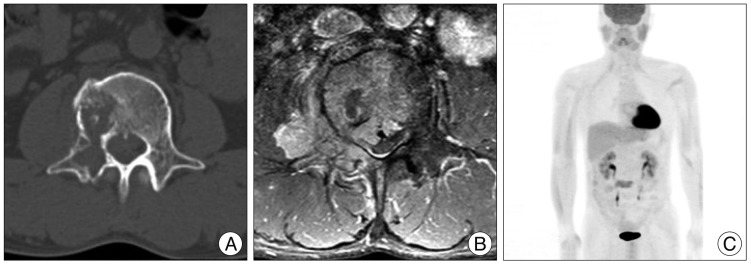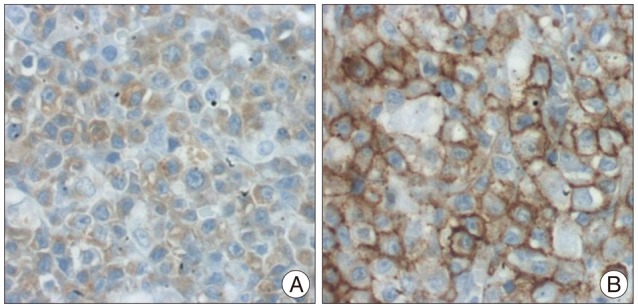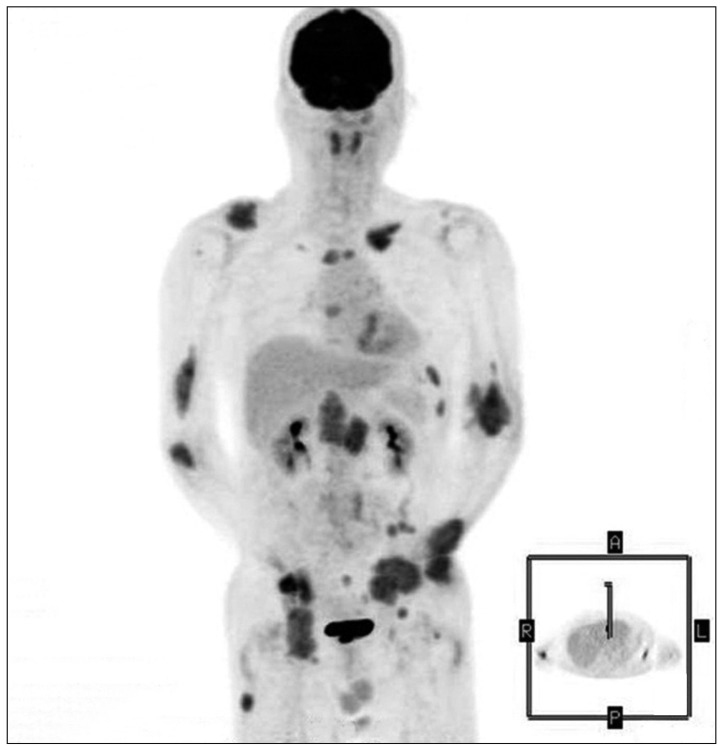J Korean Neurosurg Soc.
2013 Nov;54(5):426-430. 10.3340/jkns.2013.54.5.426.
Rapid Progression of Solitary Plasmacytoma to Multiple Myeloma in Lumbar Vertebra
- Affiliations
-
- 1Department of Neurosurgery, Spine Center, Chuncheon Sacred Heart Hospital, College of Medicine, Hallym University, Chuncheon, Korea. nssur771@hallym.or.kr
- KMID: 2138361
- DOI: http://doi.org/10.3340/jkns.2013.54.5.426
Abstract
- The prognosis of solitary plasmacytoma varies greatly, with some patients recovering after surgical removal or local fractional radiation therapy, and others progressing to multiple myeloma years later. Primary detection of progression to multiple myeloma is important in the treatment of solitary plasmacytoma. There have been several analyses of the risk factors involved in the early progression to multiple myeloma. We describe one case of solitary plasmacytoma of the lumbar vertebra that was treated with surgical decompression with stabilization and additional radiotherapy. The patient had no factors associated with rapid progression to multiple myeloma such as age, size, immunologic results, pathological findings, and serum free light chain ratio at the time of diagnosis. However, his condition progressed to multiple myeloma less than two months after the initial diagnosis of solitary plasmacytoma. We suggest that surgeons should be vigilant in watching for rapid progression to multiple myeloma even in case that the patient with solitary plasmacytoma has no risk factors for rapid progression to multiple myeloma.
MeSH Terms
Figure
Reference
-
1. Bertanha F, Boufelli G, de Camargo OP, Baptista AM, Caiero MT, de Oliveira CR, et al. Oncologic progression of bone plasmacytomas to multiple myeloma. Clinics (Sao Paulo). 2006; 61:139–146. PMID: 16680331.
Article2. Brivio F, Gilardi R, Bucocev R, Ferrante R, Rescaldani R, Vigoré L, et al. Surgery-induced decline in circulating dendritic cells in operable cancer patients : a possible explanation of postoperative immunosuppression. Hepatogastroenterology. 2000; 47:1337–1339. PMID: 11100346.3. Cappuccio M, De Iure F, Gasbarrini A, Bandiera S, Boriani S. Solitary plasmacytoma of the spine : a 22 years follow-up case report. Eur Rev Med Pharmacol Sci. 2006; 10:251–256. PMID: 17121318.4. Chakraborti C, Miller KL. Multiple myeloma presenting as spinal cord compression : a case report. J Med Case Rep. 2010; 4:251. PMID: 20691039.5. Dimopoulos M, Kyle R, Fermand JP, Rajkumar SV, San Miguel J, Chanan-Khan A, et al. Consensus recommendations for standard investigative workup : report of the International Myeloma Workshop Consensus Panel 3. Blood. 2011; 117:4701–4705. PMID: 21292778.
Article6. Dimopoulos MA, Moulopoulos LA, Maniatis A, Alexanian R. Solitary plasmacytoma of bone and asymptomatic multiple myeloma. Blood. 2000; 96:2037–2044. PMID: 10979944.
Article7. Dingli D, Kyle RA, Rajkumar SV, Nowakowski GS, Larson DR, Bida JP, et al. Immunoglobulin free light chains and solitary plasmacytoma of bone. Blood. 2006; 108:1979–1983. PMID: 16741249.
Article8. Frassica DA, Frassica FJ, Schray MF, Sim FH, Kyle RA. Solitary plasmacytoma of bone : Mayo Clinic experience. Int J Radiat Oncol Biol Phys. 1989; 16:43–48. PMID: 2912957.9. Greipp PR, San Miguel J, Durie BG, Crowley JJ, Barlogie B, Bladé J, et al. International staging system for multiple myeloma. J Clin Oncol. 2005; 23:3412–3420. PMID: 15809451.
Article10. Hogan BV, Peter MB, Shenoy HG, Horgan K, Hughes TA. Surgery induced immunosuppression. Surgeon. 2011; 9:38–43. PMID: 21195330.
Article11. Holland J, Trenkner DA, Wasserman TH, Fineberg B. Plasmacytoma. Treatment results and conversion to myeloma. Cancer. 1992; 69:1513–1517. PMID: 1540888.
Article12. Kilciksiz S, Celik OK, Pak Y, Demiral AN, Pehlivan M, Orhan O, et al. Clinical and prognostic features of plasmacytomas : a multicenter study of Turkish Oncology Group-Sarcoma Working Party. Am J Hematol. 2008; 83:702–707. PMID: 18543343.
Article13. Knobel D, Zouhair A, Tsang RW, Poortmans P, Belkacémi Y, Bolla M, et al. Prognostic factors in solitary plasmacytoma of the bone : a multicenter Rare Cancer Network study. BMC Cancer. 2006; 6:118. PMID: 16677383.14. Knowling MA, Harwood AR, Bergsagel DE. Comparison of extramedullary plasmacytomas with solitary and multiple plasma cell tumors of bone. J Clin Oncol. 1983; 1:255–262. PMID: 6668499.
Article15. Kumar S. Solitary plasmacytoma : is radiation therapy sufficient? Am J Hematol. 2008; 83:695–696. PMID: 18645990.16. Kumar S, Fonseca R, Dispenzieri A, Lacy MQ, Lust JA, Wellik L, et al. Prognostic value of angiogenesis in solitary bone plasmacytoma. Blood. 2003; 101:1715–1717. PMID: 12393501.
Article17. Liebross RH, Ha CS, Cox JD, Weber D, Delasalle K, Alexanian R. Clinical course of solitary extramedullary plasmacytoma. Radiother Oncol. 1999; 52:245–249. PMID: 10580871.
Article18. Liebross RH, Ha CS, Cox JD, Weber D, Delasalle K, Alexanian R. Solitary bone plasmacytoma : outcome and prognostic factors following radiotherapy. Int J Radiat Oncol Biol Phys. 1998; 41:1063–1067. PMID: 9719116.
Article19. Liu HY, Luo XM, Zhou SH, Zheng ZJ. Prognosis and expression of lambda light chains in solitary extramedullary plasmacytoma of the head and neck : two case reports and a literature review. J Int Med Res. 2010; 38:282–288. PMID: 20233540.
Article20. Mayr NA, Wen BC, Hussey DH, Burns CP, Staples JJ, Doornbos JF, et al. The role of radiation therapy in the treatment of solitary plasmacytomas. Radiother Oncol. 1990; 17:293–303. PMID: 2343147.
Article21. Mendoza S, Urrutia J, Fuentes D. Surgical treatment of solitary plasmocytoma of the spine : case series. Iowa Orthop J. 2004; 24:86–94. PMID: 15296213.22. Rajkumar SV, Kyle RA, Therneau TM, Melton LJ 3rd, Bradwell AR, Clark RJ, et al. Serum free light chain ratio is an independent risk factor for progression in monoclonal gammopathy of undetermined significance. Blood. 2005; 106:812–817. PMID: 15855274.
Article23. Snozek CL, Katzmann JA, Kyle RA, Dispenzieri A, Larson DR, Therneau TM, et al. Prognostic value of the serum free light chain ratio in newly diagnosed myeloma : proposed incorporation into the international staging system. Leukemia. 2008; 22:1933–1937. PMID: 18596742.
Article24. Soutar R, Lucraft H, Jackson G, Reece A, Bird J, Low E, et al. Guidelines on the diagnosis and management of solitary plasmacytoma of bone and solitary extramedullary plasmacytoma. Br J Haematol. 2004; 124:717–726. PMID: 15009059.
Article25. Soutar R, Lucraft H, Jackson G, Reece A, Bird J, Low E, et al. Guidelines on the diagnosis and management of solitary plasmacytoma of bone and solitary extramedullary plasmacytoma. Clin Oncol (R Coll Radiol). 2004; 16:405–413. PMID: 15487132.
Article26. Terszowski G, Passweg JR, Stern M. Natural killer cell immunity after transplantation. Swiss Med Wkly. 2012; 142:w13700. PMID: 23135787.
Article27. Tsang RW, Gospodarowicz MK, Pintilie M, Bezjak A, Wells W, Hodgson DC, et al. Solitary plasmacytoma treated with radiotherapy : impact of tumor size on outcome. Int J Radiat Oncol Biol Phys. 2001; 50:113–210. PMID: 11316553.28. van der Bij GJ, Oosterling SJ, Beelen RH, Meijer S, Coffey JC, van Egmond M. The perioperative period is an underutilized window of therapeutic opportunity in patients with colorectal cancer. Ann Surg. 2009; 249:727–734. PMID: 19387333.
Article





